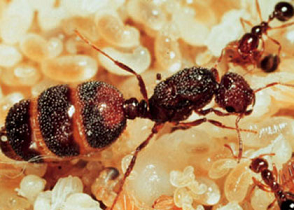As we learned, five Virginia spiders weave unique webs: the Arrow-Shaped Micrathena Spider, the Black and Yellow Garden Spider, the Bowl and Doily Spider, and the Grass Spider. Today we’ll talk about the last two.
Grass Spider
Web Design: Grass Spiders weave funnel shaped webs with a large “sheet web” that covers small plants, such as grass. Unlike most webs, these are not sticky. The spiders spend their time in the funnel, and this is the location where they will most likely live their entire lives. As the spiders matures, the sheet covering the plants will slowly increase in size until it covers a large area. The egg sacs are large clumps of spun silk that looks matted. The sheet part of the web is used to ensnare the spiders’ victims, such as small crawling and flying insects. When the insect walks on top of the sheet, and because the web isn’t sticky, the sheet vibrates letting the spider know that it has company. The spiders will then quickly dash out of the funnel, grab its prey, and drag it back down into the funnel for a snack!
Favorite Hiding Spots:
- In the funnel of the web, under the sheet
- Grassy areas, stone fences, and small shrubs
- Are most commonly found among “leaf litter” (areas between leaves or twigs, under stones, or in crevices)
Defense Mechanism: Grass Spiders hide under the large top sheet of the web, in the funnel. However, just in case, these spider have last minute escape routes built into their webs as well. This escape route is always at the other end of the funnel, so if these spiders feel threatened they will just run out their “back door”.
Fun Fact: Grass Spiders can be coaxed out of their funnel by lightly tapping the outer sheet of the web. But be careful, the spider may bite out of defense! The bite will only have localized pain, redness, swelling, and itching.
Brown Recluse Spider
Web Design:Brown Recluse Spiders have abnormally sticky webs. Other than that, there is no standard for what they look like as they have no specific design to the web, and instead the webs appear to have been carelessly constructed. This is because they only weave webs for nesting purposes, instead of as a trap for insects. These spiders prey on small insects that are found in or around the home.
Favorite Hiding Spots:
-
Dark, hidden areas
-
Tucked away into corners and holes
-
In attics and crawlspaces
-
Under objects (such as furniture) and in boxes
Defense Mechanism: The primary defense of Brown Recluse Spiders are their venomous bites. Although these spiders are rarely aggressive, they will bite any time that they feel threatened or are provoked. This includes any time they are pressed against the skin, such as when brushed against or caught in clothing. Their bites can be deadly for humans, as they cause tissue necrosis (which means that it causes premature death of cells in living tissue). Because of this, medical attention should be sought immediately after being bitten. In addition to their venom, these spiders use their dark brown and tan color to hide in their dark resting spots, which is especially useful during the day, as they are nocturnal. Brown Recluse Spiders also have many adaptations, including the ability to survive long periods of time without food or water, or after losing limbs.
Symptoms of a Bite: Bites may or may not be felt, but the pain will begin within the first few hours after being bitten. This may be accompanied by an itching sensation at the location of the bite, and the area will become red and swollen. The effects will worsen over the next 12 to 36 hours, and will include nausea, vomiting, fever, and muscle and joint pain. After a few days without medial attention necrosis will develop, as the skin and tissue will begin to die and atrophy, leaving an open, painful sore that won’t heal. Without medical attention, this will eventually lead to organ damage and death. Therefore, medical attention must be sought immediately after noticing the bite. Children and the elderly are the most common victims that end in a fatality.
Fun Fact: Brown Recluse Spiders are not actually common to Virginia, but are found here after being brought through odd means of transportation. For instance, the spiders can be brought through suitcases or old boxes!
Regardless of what species of spider that you’re having an issue with, PermaTreat is able to take care of your problem!







































































